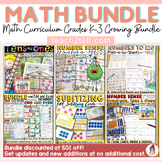60 results
High school graphing interactive notebooks for Microsoft Word
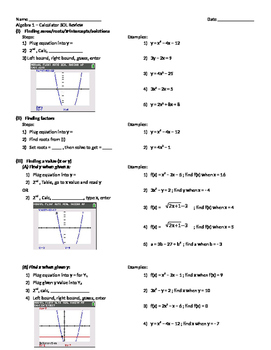
Algebra 1 Calculator Review (TI-84)
Comprehensive review of all graphing calculator concepts taught through the Algebra 1 course. Review concepts include finding roots, factors, values (x or y), y-intercept, mean, standard deviation, line/curve of best fit, and finding solutions to systems of equations. The review include steps and screenshots of the calculator.
Subjects:
Grades:
7th - 12th, Higher Education, Adult Education
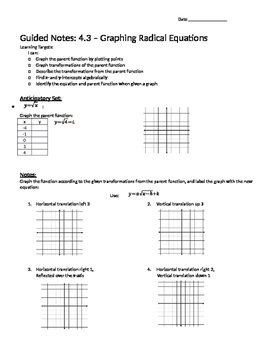
Graphing Square and Cube Root Functions - Notes
Guided notes teaching how to graph square root and cube root functions by translating the parent function. I teach my students to use the "base points" [ (0, 0), (1, 1), and (4, 2) or (-1, -1) for square/cube root] and then transform them using (h, k) or vertex form. They also must be able to determine transformations and equations from a graph. The notes are a summation of the whole unit so they must graph equations at the end and also find the domain/range as well as find x- and y-intercepts a
Subjects:
Grades:
9th - 12th, Higher Education, Adult Education
Types:
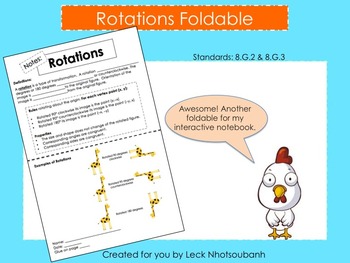
Transformations: Rotations Foldable for Interactive Notebooks
This foldable can be used as notes to introduce rotations to the students. This is a refreshing way for students to take notes.
This foldable contains:
vocabulary, examples of rotations, common core problems, and an answer key. This foldable was created on Microsoft Word so you can edit it to your liking. I have a PowerPoint presentation that corresponds with this foldable also.
Grades:
7th - 11th
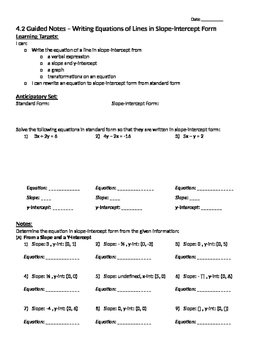
Writing Equations in Slope-Intercept Form - Notes
Guided notes teaching students how to write equations in slope-intercept form when given a graph, a slope and a y-intercept, and a verbal explanation. The notes also teach how to transform equations in slope-intercept form when given vertical shifts and "stretches" in the steepness/flatness of the line. The beginning of the notes also reviews how to find the slope-intercept form of an equation written in standard form by solving for y. I also have a corresponding assignment of the same name.
Grades:
7th - 12th, Higher Education, Adult Education
Types:

Algebra 2 Calculator Review (TI-84)
Comprehensive review of all graphing calculator concepts taught through the Algebra 2 course. Review concepts include finding roots,values (x or y), mean, standard deviation, line/curve of best fit, minimums/maximums, intervals of increase/decrease, domain and range, and finding solutions to systems of equations. The review includes steps and screenshots of the calculator.
Subjects:
Grades:
9th - 12th, Higher Education, Adult Education
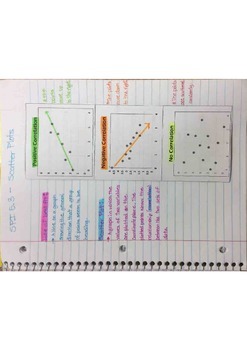
Scatter plots Foldable (TN SPI 8.5.3)
This is a foldable describing positive correlation, negative correlation, and no correlation. The preview of this product is a couple of pictures of the foldable and notes over scatter plots that my students created and put in there Math Journal.
TN SPI 8.5.3
Grades:
6th - 9th
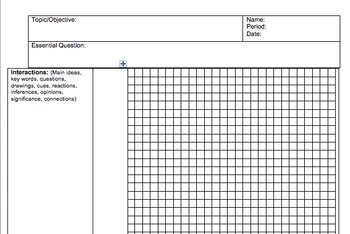
Cornell Notes for Graphing - Math/Science (editable)
Similar in design to my free Cornell Notes template, this template includes 2 pages for graphing and taking notes on it. The right side of both pages is graph paper with room for labels and increments and the left side is room for notes and prompts for students to reflect on their graphs. The document is compatible with word and able to be edited to reflect specific needs you may have.
Grades:
3rd - 12th, Higher Education, Adult Education
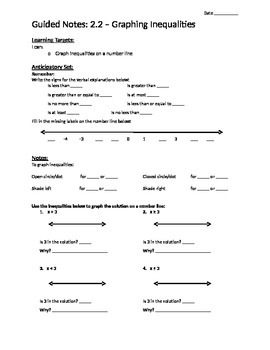
Graphing Inequalities on a Number Line - Notes
Notes teaching students how to go to/from an algebraic inequality to/from a verbal expression to/from a graph on a number line. The notes also contain examples of finding numbers that are in and not in the solution set from the graph, the verbal expression, and the algebraic inequality. The beginning also contains a review of the verbal expressions used to represent less than, greater than or equal to, at most, no less than, etc. I also have a corresponding assignment of the same name.
Grades:
7th - 12th, Higher Education, Adult Education
Types:
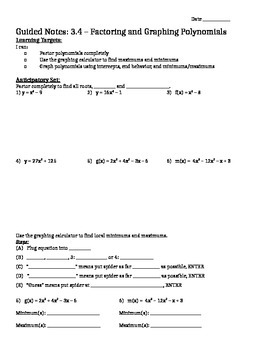
Factoring and Graphing Polynomials in Standard Form - Notes
Guided notes teaching how to graph polynomials in standard form using the end behavior, algebraically found x-intercepts by factoring, y-intercept and the reflection of the y-intercept, and the minimums/maximums found on the graphing calculator. Emphasis is on non-calculator based solving, and only using the calculator to find local min/max. I also have a corresponding assignment of the same name.
Subjects:
Grades:
9th - 12th, Higher Education, Adult Education
Types:
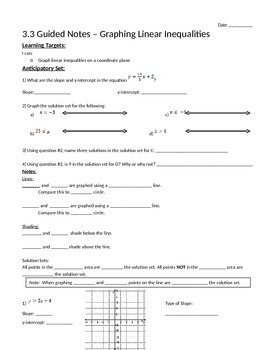
Graphing Linear Inequalities - Notes
Guided notes teaching students how to graph linear inequalities on a coordinate plane. Emphasis is on "pulling out important information" first, such as slope, y-intercept, type of line (dotted/solid), and shading location, and then using that information to graph. I have also included linear equations to emphasize the difference between shaded graphs and non-shaded graphs. The Performance of Understanding questions at the end challenge students to match the given graphs to the equations. Horizo
Grades:
7th - 12th, Higher Education, Adult Education
Types:

Graphing Linear Inequalities with and without a calculator
This is a tri-fold foldable that meets in the middle. On the left side are guided notes explaining the process for graphing linear inequalities using the x and y intercepts. On the right side are the steps for graphing inequalities using a TI-84 calculator. It helps to have the updated firmware for the calculator with access to the Inequalz application but test points can be used as well. In the middle are practice problems that can be used as examples with the guided notes or as practice fo
Subjects:
Grades:
9th - 12th
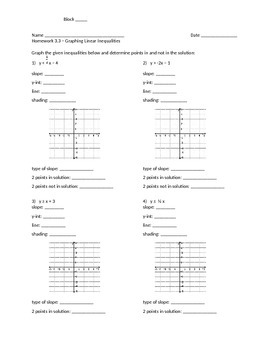
Graphing Linear Inequalities - Assignment
Assignment testing the ability to graph linear inequalities on a coordinate plane. Emphasis is on "pulling out important information" first, such as slope, y-intercept, type of line (dotted/solid), and shading location, and then using that information to graph. I have also included linear equations to emphasize the difference between shaded graphs and non-shaded graphs. Horizontal and vertical lines are included. Bonus questions at the end test the ability to determine an equation/inequality fro
Grades:
7th - 12th, Higher Education, Adult Education
Types:
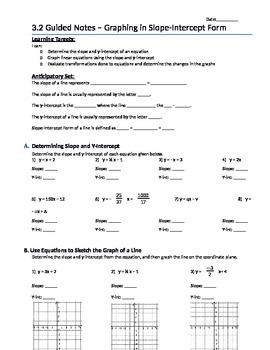
Graphing in Slope-Intercept Form - Notes
Guided notes teaching students how to determine the slope and y-intercept from an equation and graph lines in slope-intercept form. Performance of Understanding question at the end has students evaluate how transformations done to linear equations changes the graphs (change in y-intercept section and change in slope section). I also have a corresponding assignment of the same name.
Grades:
7th - 12th, Higher Education, Adult Education
Types:

Polynomial End Behavior Investigative Task
Guiding by a worksheet, students will sort equations for polynomial functions (which have a picture of their graphs) by Even vs. Odd degrees. Then they will further sort into Positive/Negative leading coefficients. They will develop the rules for what determines the end behavior of the graphs.
Subjects:
Grades:
9th - 12th
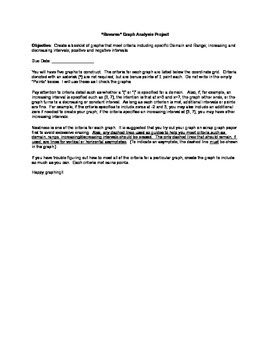
"Reverse" Graph Analysis Project
A template for a booklet of 5 coordinate grids along with specific criteria in a rubric below each grid. Student must create graphs that meet criteria such as specific domain, range, increasing/decreasing intervals, positive/negative intervals, zeros, y-intercepts. Editable student instructions are included.
Subjects:
Grades:
9th - 12th
CCSS:
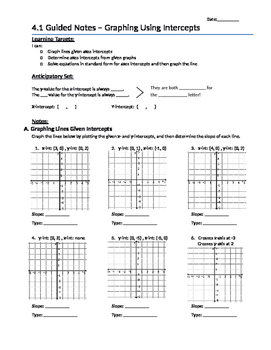
Graphing Equations in Standard Form by Finding Intercepts - Notes
Guided notes teaching students how to convert linear equations from standard form to slope-intercept form, as well as how to find x- and y-intercepts algebraically to graph lines and determine the slope-intercept form. The performance question at the end has students compare the solving for y method and the finding intercepts method on the same equation to create meaningful connections. I also have a corresponding assignment of the same name.
Grades:
7th - 12th, Higher Education, Adult Education
Types:

Solve Quadratics using Zero Product Property and sketch a graph
Cornell Notes solving quadratics using the zero product property. The Cornell like notes includes a linear sample to introduce the word "zeros" as the x-intercept" which will also include the other vocabulary terms such as "roots" "x-intercept(s)" "solutions" . Students will keep this in their interactive notebooks and will then complete the practice worksheet to solve quadratic equations using the zero product property and sketch the graph to include the "zero's" and the y-intercept.
There
Subjects:
Grades:
8th - 11th
Types:
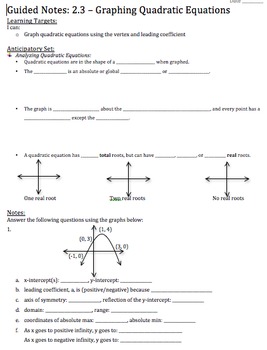
Graphing Quadratic Equations in Vertex Form - Notes
Guided notes teaching how to graph quadratic equations in (h, k) or vertex form. Notes start with graphing the parent function, and then continue with how a, h, and k affect and translate a quadratic graph. Important aspects like domain, range, x-and y-intercepts, axis of symmetry, etc are also included. I also have an assignment of the same name.
Subjects:
Grades:
9th - 12th, Higher Education, Adult Education
Types:
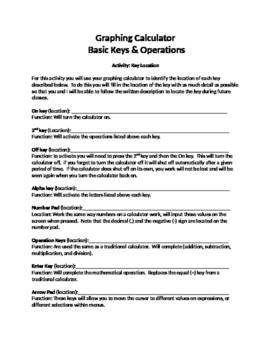
Graphing Calculator Basic Key Operations Activity
This activity introduces students to the graphing calculator. It identifies some basic keys and their operations, but has the students identify the location of the key. A good activity to have students start to play around and get comfortable with the graphing calculator. It was originally designed for the Ti-84 but can be easily modified for other models.
Subjects:
Grades:
8th - 11th

Graphing Motion
This foldable is the perfect exploration guide for learning/teaching how to use graphs to describe motion.
Students will graph two examples of positive acceleration;two examples of negative acceleration; and one example of a distance-time graph. Students will be able to compare the steepness of a faster-moving object to that of a slower-moving object. Also, the distanc
Subjects:
Grades:
7th - 9th

Interpreting Functions - Notes
Guided notes teaching students how to find domain, range, and values in each when given a set of coordinates, a function map, a table, and a graph. Values are written using function notation, as in find f(3) or find x when f(x) = 0, and students must also determine if the set, map, table, or graph are functions by checking for a repeating domain value or using the vertical line test. The performance question at the end has students express a set of values using multiple representations, such as
Grades:
7th - 12th, Higher Education, Adult Education
Types:

Pythagorean Theorem Triangle Foldable
This is a 3 fold pedal foldable that contains interactive, fill-in-the-blank notes on finding the leg, finding the hypotenuse, finding square root of a number review, and tips and tricks! Step-by step notes are good for intervention and special education classes. Works great as a reference in interactive notebooks.
Check out the worksheet that coordinates with the foldable which uses similar problems and matching clipart in my store!
Pytahgorean Theorem Triangle Foldable by Suzie's Angle is l
Grades:
8th - 11th
CCSS:

Using Synthetic Division to Graph Polynomials - Notes
Guided notes teaching how to find additional roots by using synthetic division and factoring, and then graphing using the roots, y-intercept, and end behavior. Emphasis is on non-calculator based learning and graphing. I also have a corresponding assignment of the same name.
Subjects:
Grades:
9th - 12th, Higher Education, Adult Education
Types:

Coordinate Plane Flip Book/ Quadrants
Help students learn the 4 quadrants on the coordinate plane using this fun flip book!
Review terms like "origin" and the location of the x and y axis.
Then, practice plotting points and determining what quadrant they belong in.
Grades:
6th - 9th
CCSS:
Showing 1-24 of 60 results


